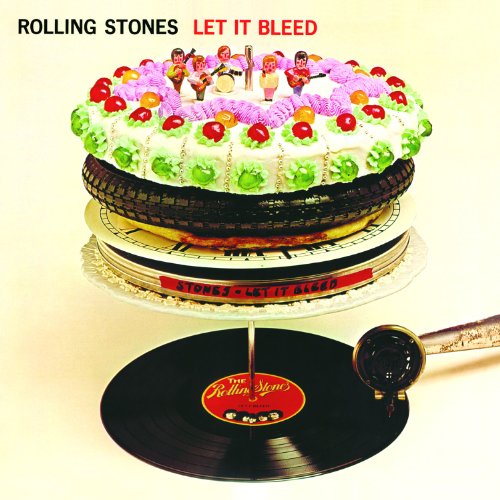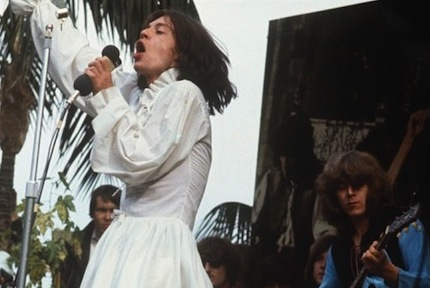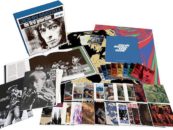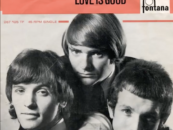 The Rolling Stones’ Let It Bleed captures the band at its creative apogee through a dark masterpiece that mirrors the violent ’60s milieu in which it was created—a definitive work that cemented the Stones’ importance even as founder Brian Jones exited the band, leaving Mick Jagger and Keith Richards to shape the Stones’ sound and sensibility. By the time sessions for the album began in November 1968, Jones’ slow-motion retreat rendered him a no-show for most recording dates, distracted by substance abuse and depression.
The Rolling Stones’ Let It Bleed captures the band at its creative apogee through a dark masterpiece that mirrors the violent ’60s milieu in which it was created—a definitive work that cemented the Stones’ importance even as founder Brian Jones exited the band, leaving Mick Jagger and Keith Richards to shape the Stones’ sound and sensibility. By the time sessions for the album began in November 1968, Jones’ slow-motion retreat rendered him a no-show for most recording dates, distracted by substance abuse and depression.
That dynamic had already underpinned the artistic and commercial success of the previous album, Beggars Banquet, which found Richards and Jagger navigating away from psychedelia and mod pop-rock to renew their original focus on blues, adding heightened country and acoustic blues accents. That album was also their first with production by American expat Jimmy Miller, whose arrival coincided with a sharpened sonic focus. While engineer Glyn Johns, who had worked on every Stones album since 1965, would later insist that “Mick and Keith really produced the records they made,” a significant leap in sound quality and a supple rhythmic feel would prove common denominators for the five studio albums produced by Miller.
Regardless of how credit is parsed, it’s hard to dispute the consensus that the first four of those five LPs—from Beggars Banquet through Exile on Main Street—represent the Stones’ most potent streak of full-lengths.
Beggars Banquet also signaled a political awakening, kindled in the wake of the 1967 drug busts that ensnared Jagger, Jones and Richards, and tied them to the emerging counterculture. Sociopolitical turmoil on both sides of the Atlantic, including the assassinations of Robert F. Kennedy and Dr. Martin Luther King, and the spring student riots in France, inspired a new sense of outrage: “Sympathy for the Devil” and “Street Fighting Man” were barricade anthems from a band that was previously content to smirk over middle class hypocrisy and familiar sexual and romantic tropes.
The next album’s opening salvo was forged by an even more remorseless view of a world on fire. “Gimme Shelter” creeps into view on Richards’ quietly ominous guitar notes until Charlie Watts’ snare hits strike like cracks of rifle fire and Jagger leads us into a raging storm where war, rape and murder threaten “my very life today.”
Jagger’s howl and Richards’ stabbing guitars would already qualify “Gimme Shelter” as a brutally effective rocker, but a scorching guest vocal from Merry Clayton, the gospel-trained backing singer drafted the night of the session, transports us into a hellish nightmare. The performance reflects the newly prominent role of female vocals as part of the Stones’ sonic palette, first introduced through a mixed gospel choir on the previous album’s “Salt of the Earth.”
Related: That haunting vocal on “Gimme Shelter”
As on Beggars Banquet, the Stones cushion the fury with more subdued moments. Here, they follow the maelstrom of “Gimme Shelter” with the set’s lone cover, “Love in Vain,” a Robert Johnson blues classic revered by Richards, that veers from Johnson’s haunted Delta blues with the country accent of Ry Cooder’s tremulous mandolin.
If you’re a new Best Classic Bands reader, we’d be grateful if you would Like our Facebook page and/or bookmark our Home page.
(Cooder’s presence merely hints at the Californian virtuoso’s influence on the Stones: Apart from introducing Richards to the open G tuning crucial to “Gimme Shelter” and other signature Richards guitar riffs, the iconic guitar figure that dominates “Honky Tonk Women,” recorded during the Let It Bleed sessions, is openly modeled on Cooder’s bold style.)
The country vein traced on “Love in Vain” segues into “Country Honk,” which recasts “Honky Tonk Women” as preying on a more bumptious country cousin of Jagger’s sated lover. “Live With Me” extends that cheerful carnality in an R&B romp buttressed by Leon Russell’s barrelhouse piano and muscular horn arrangement, followed by the title track’s likeminded celebration of sex, drugs and rock ’n’ roll, ending the original first side of the LP.
With “Midnight Rambler,” however, the lubricious fun ends as murderous darkness descends as Jagger first warns of, and then becomes, a serial killer. Sex and violence stalk a stomping, four-square blues vamp that would be further extended live, and captured in a scorching live version on Get Yer Ya-Ya’s Out, recorded on the ’69 tour.
The pace again slows for “You Got the Silver,” a happy accident that gave Keith Richards his first solo lead vocal on an unexpectedly warm ballad. Glyn Johns would later confess that he bungled the mix after producer Miller suggested putting reverse echo on Richards’ lead guitar, an effect that required turning the tape upside down to be run backwards while recording the echo to an empty track. Johns’ miscalculation erased Jagger’s original vocal. With Jagger a hemisphere away in Australia, filming Ned Kelly, Richards recorded the new lead.
A lovely melody and Richards’ affectingly tender, vulnerable vocal are complemented by a layered arrangement decorated with guitar and autoharp (the latter one of Jones’ final contributions to a Stones track) and Nicky Hopkins, whose organ spreads a celestial canopy above the song.
Sessions for the album had been scattered throughout the months before Jones’ death on July 3, 1969. As fate would have it, the initial November sessions produced the album’s most majestic moment, “You Can’t Always Get What You Want.” A master class in cinematic record production, the song begins with the London Bach Choir setting the scene with chaste diction and rich harmonies that suggest a cathedral more than the song’s mean streets:
I saw her today at the reception, a glass of wine in her hand
I knew she was going to meet her connection, at her feet was a footloose man
You can’t always get what you want…
Quiet acoustic guitar and a delicate French horn lead us to Jagger’s solo repetition of the opening verse until he sings, “But if you try some time, you just might find/You’ll get what you need,” and the track takes flight, lifted by Al Kooper’s organ and piano lines and Jimmy Miller’s swinging, syncopated drumming. The arrangement swells in scale and momentum, the weary fatalism of the lyrics suggesting an existential hymn. As the final track and the answer to the violent menace of “Gimme Shelter” and “Midnight Rambler,” “You Can’t Always Get What You Want” witnesses the Stones staring into an abyss.
The day after the album’s December 5, 1969 release, the abyss came to the band at the Altamont Speedway, where the hastily organized free festival descended into its own chaos and the stabbing death of concert attendee Meredith Hunter. The Rolling Stones would continue to flex their new musical strength for two more albums, but the real-life murder at Altamont left the band shaken. They would never again gaze so steadily into the darkness.
[A 50th anniversary edition of Let It Bleed was released in November 2019.]
Related: Our look at the live album Get Yer Ya-Ya’s Out
- Dr. John’s ‘Gumbo’: A New Orleans Master’s Thesis - 04/20/2024
- Crosby, Stills, Nash & Young’s ‘Deja Vu’: A Volatile Chemistry - 04/18/2024
- Manassas: Stephen Stills’ Finest (Solo) Hour - 04/12/2024







13 Comments so far
Jump into a conversationYou failed to mention “Monkey Man” in your review. Great cut and an indispensable balance to the two tracks that precede and follow it.
I was initially intrigued by Byron Berline’s fiddle virtuosity used on country honk. Also, the car horn always made guests look out the window as if their ride had arrived
I love this album, it was the first record me and my late sister Jean played on a new Harmon Kardon stereo we bought together
I think that “Midnight Rambler” was poorly recorded. If it had the bombast and clarity of, say, “Monkey Man” it would have sounded fantastic. Instead, it drags along too slowly and it sounds like a mono recording that was taped on a cheap eight track tape recorder.
“Gimme Shelter” is actually played in Open E.
without a doubt best stones album ever
Live with Me and Let it Bleed
Great tunes on this great album.
Best Stones album for sure
I played this album so many times!
“Let It Bleed” is so great it can be a stand alone ‘best of’ album!
One of the top-5 best Rolling Stones albums.
Nicely written review, Sam.
For the rockologists and guitar players out there, in response to this section referring to Ry Cooder’s influence on The Stones:
“Apart from introducing Richards to the open G tuning crucial to “Gimme Shelter” and other signature Richards guitar riffs…”
The main riff and rhythm guitar that Keith played in “Gimme Shelter” that begins with the intro and runs throughout the song is in fact an open “E” tuning. Not open “G”. While Ry may have put Keith on to the “G” tuning prominent in tracks like “Honky Tonk Women”, “Brown Sugar”, “Start Me Up”, and many others, it wasn’t used on “Gimme Shelter”. And by the way, in most live videos and live albums we hear of The Stones performing “Gimme Shelter”, all the way up to the most recent tours, and The X-Pensive Winos also for that matter, Keith plays the song in standard. This is the reason that (IMHO) “Gimme Shelter” live has never quite reproduced the ominous mood of the original recording. The open “E” tuning changes the vibe considerably. Another example of Keith playing an open “E” tuning would be “You Got The Silver”.
Enjoy!
I just turned 70 and for 50 something years this has been my ultimate Stones favorite.
This was Mick Taylor’s introduction into the band. Mick Taylor as lead guitarist saw the band go from pop to “The Greatest Rock and Roll Band.” Their Best albums were created when Taylor was in the band. After he left in December of 1975, The Stones musically never recovered.
That delicate French horn solo also came by way of Al Kooper, and he’s rather proud of it, especially being as it was that Al didn’t really know how to play the French horn. He said in his book that it was the best of his approximately 100 takes. He also said he never heard back from the guys in the band after his contributions, but one day several months later, he’s riding in his car, and the song comes on the radio. WITH his French horn solo!